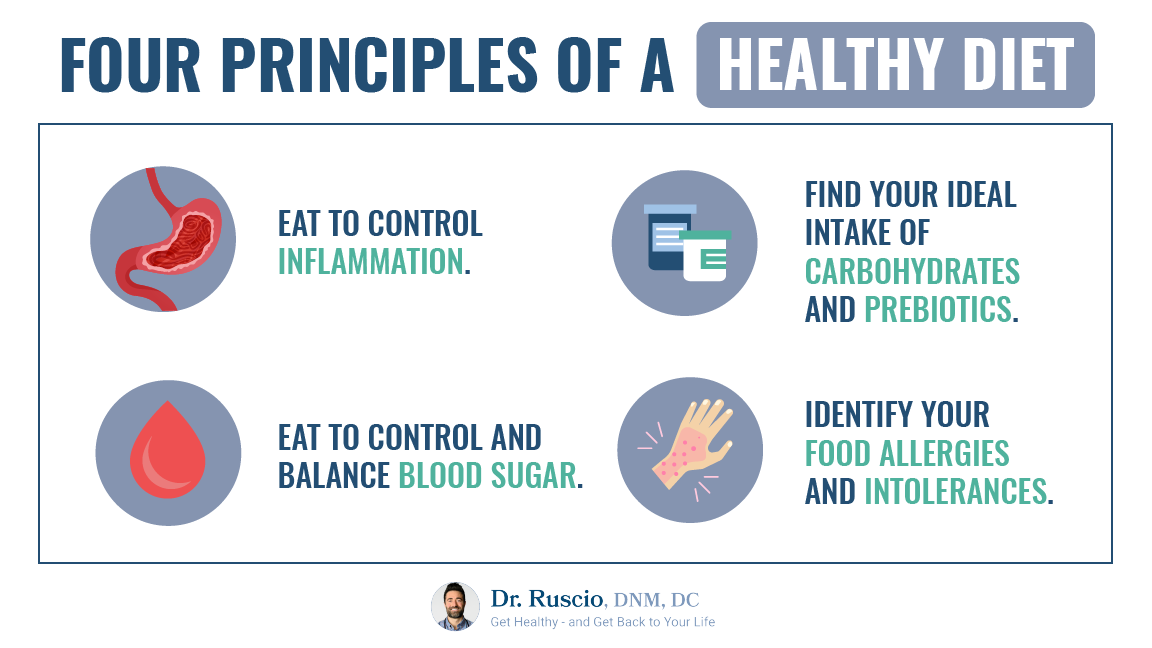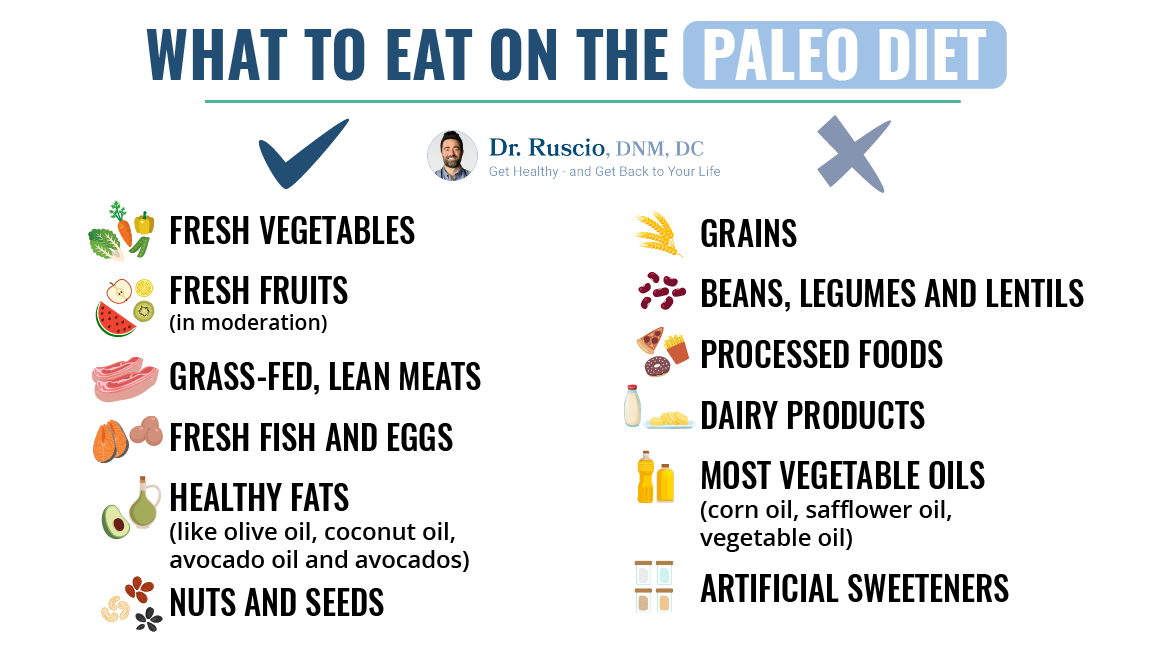What is the Paleo Diet?
Why I Recommend It and How to Tell if It’s Right for You
- What Is the Paleo Diet?|
- 4 Key Diet Principles|
- Health Benefits|
- Criticisms|
- Is Paleo Right for You?|
- What to Eat|
- Tips and Troubleshooting|
- Bottom Line|
My health advice for new patients almost always starts with dietary improvements. And while there are lots of good, healthy diets you can follow, I recommend the Paleo diet the most often.
What Is the Paleo Diet?
The Paleo diet mimics what our ancestors ate during the stone age or Paleolithic era. During this time, humans were not yet growing agricultural crops.
The basic idea behind the Paleo diet is our digestive systems have not evolved much since Paleolithic times and that a stone-age diet is more biologically appropriate for humans and, therefore, better for our health.
The Paleo diet restricts processed foods and encourages you to eat a wide variety of healthy, whole foods.
The Paleo Diet Checks Off Four Key Diet Principles
There are four important principles when it comes to healthy eating, and the Paleo diet can help with all of them. The four principles are:
- Eat to control inflammation.
- Eat to control and balance blood sugar.
- Find your ideal intake of carbohydrates and prebiotics.
- Identify your food allergies and intolerances.

Let’s take a closer look at the Paleo diet’s benefits.
The Paleo Diet Helps Control Inflammation
Inflammation is linked to a litany of chronic health conditions, including inflammatory bowel disease, [1] rheumatoid arthritis, [2] gum disease, [3] autoimmune disease, [4] and even heart disease. [5, 6]
The paleo diet helps to calm inflammation by minimizing your exposure to foods that provoke an immune response. [7, 8] These include sugars, unhealthy fats, chemical additives, and common problem foods like dairy, gluten, and soy.
By controlling inflammation, you also create a healthier environment for gut bacteria and thus improve your gut microbiome. [9, 10] With a healthier microbiome, inflammation reduces further. [11, 12]
This shows how a simple dietary change can lead to a self-perpetuating cycle of healing.
The Paleo Diet Helps Balance Blood Sugar
The Paleo diet is much lower in carbs than the standard American diet, as it eliminates grains, beans, pulses, and all refined sugars. This makes it a great choice for helping to balance blood sugar. [13, 14]
Staying off the blood sugar roller coaster is really important for maintaining a healthy metabolism, keeping your energy steady, reducing stress and sleeping better. And of course, it also prevents type 2 diabetes.
The Paleo Diet May Reduces Carbs and Increase Prebiotics
The amount of dietary carbohydrates you need to fuel your body is highly individual. Some will do better with less, and some will do better with more.
Prebiotics are the fibers that feed gut bacteria. While feeding your gut bugs can be a good idea, this is not true for everyone. Prebiotics feed both good and bad bacteria and may cause symptoms to flare up in people with gut imbalances.
If you currently eat a standard American diet, the Paleo diet will reduce your carb intake and increase your prebiotic intake. This is a great opportunity to find out if you do better on a lower carb, higher prebiotic diet.
The Paleo Diet Eliminates Common Problem Foods
Food allergies and food intolerances are also highly individual. To have a healthy diet, we must each identify our specific problem food issues.
This principle is closely linked to the principle of eating to control inflammation. Identifying and avoiding your own problem foods is an important part of preventing inflammation.
Food allergies, like a peanut allergy, are usually fairly obvious, as the immune response tends to be immediate and strong. Food intolerances can be much trickier to identify because the reaction may be delayed and symptoms can be a bit vague. Examples of symptoms can include brain fog, fatigue, and irritability.
With the Paleo diet, you don’t eat problematic foods like gluten grains, dairy, and soy. You also eliminate the chemicals and preservatives found in processed foods.
Many of my patients experience a significant reduction in symptoms after a few weeks on the Paleo diet. By reducing the burden of symptoms, it becomes much easier to identify your problem foods through a process of trial and error, over time.
What the Research Shows About the Paleo Diet
There’s certainly more anecdotal data about the health benefits of the Paleo diet than research. The few studies conducted were small and mostly focused on patients with metabolic syndrome and type 2 diabetes.
Here’s a quick summary of what the research tells us so far.
Weight Loss
The few studies available showed the Paleo diet was effective for weight loss and reducing waist size. [15, 16, 17] When compared to other dieting approaches, the Paleo diet was more effective.
However, in the only longer-term study available, post-menopausal women lost more weight than other dieters after six months, but by 24 months, weight loss results were similar for both groups. [18]
Metabolism
Research suggests that the Paleo diet is effective for controlling the markers of metabolic syndrome and type 2 diabetes. These conditions increase your risk of heart disease and other chronic diseases. Here’s what we found during our research:
- Cholesterol: The Paleo diet was more effective for reducing triglycerides and improving HDL cholesterol compared to other diets. [19]
- Blood pressure: The Paleo diet was more effective for reducing blood pressure, although the difference here was small. [20]
- Blood sugar: The Paleo diet was slightly better for reducing blood sugar compared to other diets. [21]
Criticisms of the Paleo Diet
Critics of the so-called “caveman diet” suggest that it is too high in saturated fats and too low in calcium and vitamin D.
This may be true if you approach the Paleo diet narrowly. For example, many modern Paleo dieters rely heavily on grass-fed beef as a protein source. But keep in mind there were many different hunter-gatherer cultures worldwide and the hunter-gatherer diet was incredibly diverse.
A study into the diets of world-wide hunter-gatherer cultures shows some interesting geographic trends [22]:
- Hunter-gatherers closest to the equator ate more plant-based foods and less animal-based foods.
- Further north, the percentage of animal-based food in the hunter-gatherer diet increases.
- However, for most northern hunter-gatherer groups, fish was a more important protein source than game.
So, one tip for the Paleo diet is to include a lot of fish and seafood in your diet. This will lower the saturated fat and increase fatty acids and vitamin D. Also, adding leafy greens like kale, [23] nuts, and seeds will make up for the lack of dairy in your diet.
Is the Paleo Diet Right for You?
There’s no such thing as one magic diet that works for everyone.
The Paleo diet works because it focuses on healthy, whole foods and reduces the number of problem foods that typically cause inflammation and immune reactions.
The best way to find out if the Paleo diet works for you is to try it for 2-3 weeks. If you feel better after that period of time, you’ll be motivated to keep going. If it makes no difference in how you feel, then there is no need to continue.
What to Eat on the Paleo Diet
Here is a simple overview:

What to eat:
- Fresh vegetables
- Fresh fruits (in moderation)
- Grass-fed, lean meats
- Fresh fish and eggs
- Healthy fats, like olive oil, coconut oil, avocado oil and avocados
- Nuts and seeds
What not to eat:
- Grains
- Beans, legumes, and lentils
- Processed foods
- Dairy products
- Most vegetable oils (corn oil, safflower oil, vegetable oil)
- Artificial sweeteners
There are a few grey areas regarding the Paleo diet. Some people avoid starchy veggies like sweet potatoes. Others stay away from whole grains but may include a little white rice. Organic is always good, but it’s expensive. Buy what you can afford.
Like any healthful diet, it doesn’t pay to obsess about every morsel. Follow the basic guidelines of the diet plan, but don’t drive yourself crazy trying to adhere to a perfect Paleo eating plan.
For a detailed guide, check out the Whole 30 Paleo Diet Program.
Tips and Troubleshooting
Keep it simple to start. Develop a simple food list and stick to a basic menu plan. This is not the time to try a lot of new or fancy recipes. Once you are comfortable with your dietary changes and know the diet works for you, find a good cookbook and start to expand your menu options.
Stay close to the Paleo diet guidelines at first, and then adapt slowly to suit your needs. A lot of my patients continue to eat Paleo but may add back rice or some high-fat dairy and still feel fine. If there is a food you really miss, try adding it back and see how you feel.
If You’re Not Getting Enough Carbs
Some people don’t do well on a low-carb diet. If you are losing too much weight or feel weak and fatigued, try adding back more carbs while sticking to the basic paleo template. White rice and starchy vegetables are a good place to start.
The Paleo diet is quite flexible and doesn’t have to follow a high-protein, low-carb formula.
If You Want More Gut Support
A healthy diet is always the first step in improving your gut health and overall health. The next step is taking probiotics. Diet and probiotics are the first two steps in the Great-in-8 plan, as described in my book, Healthy Gut, Healthy You.
If You Don’t See Enough Improvement
If you have tried the Paleo diet for a few weeks and don’t see enough symptom improvement, there are a couple of different approaches you can take.
- Autoimmune Paleo diet: This is a more restrictive version of the Paleo diet that removes some of the less common food allergens. For some people, this is the missing piece. Remember, fewer allergens equals less inflammation.
- Low-FODMAP diet: helps to reduce bacterial overgrowth by restricting foods that feed bacteria. This diet has been shown to be especially helpful for IBS patients. [24, 25, 26, 27, 28, 29, 30, 31, 32, 33]
These diets are more challenging than the Paleo diet, so only try these if necessary.
Paleo Diet: the Bottom Line
The Paleo diet works by removing many of the foods that can cause inflammation and immune reactions.
It’s worth a 2-3 week trial if you have an inflammatory condition or you struggle with troublesome symptoms like headaches, brain fog, joint pain, fatigue or irritability.
While the Paleo diet doesn’t work for everyone, I’ve seen this diet plan make a big difference in the quality of life for many patients.
Dr. Michael Ruscio is a DC, natural health provider, researcher, and clinician. He serves as an Adjunct Professor at the University of Bridgeport and has published numerous papers in scientific journals as well as the book Healthy Gut, Healthy You. He also founded the Ruscio Institute of Functional Health, where he helps patients with a wide range of GI conditions and serves as the Head of Research.➕ References
- Zhang YZ, Li YY. Inflammatory bowel disease: pathogenesis. World J Gastroenterol. 2014;20(1):91-99. doi:10.3748/wjg.v20.i1.91
- Coates LC, FitzGerald O, Helliwell PS, Paul C. Psoriasis, psoriatic arthritis, and rheumatoid arthritis: Is all inflammation the same?. Semin Arthritis Rheum. 2016;46(3):291-304. doi:10.1016/j.semarthrit.2016.05.012
- Carrizales-Sepúlveda EF, Ordaz-Farías A, Vera-Pineda R, Flores-Ramírez R. Periodontal Disease, Systemic Inflammation and the Risk of Cardiovascular Disease. Heart Lung Circ. 2018;27(11):1327-1334. doi:10.1016/j.hlc.2018.05.102
- Clemente JC, Manasson J, Scher JU. The role of the gut microbiome in systemic inflammatory disease. BMJ. 2018;360:j5145. Published 2018 Jan 8. doi:10.1136/bmj.j5145
- Carrizales-Sepúlveda EF, Ordaz-Farías A, Vera-Pineda R, Flores-Ramírez R. Periodontal Disease, Systemic Inflammation and the Risk of Cardiovascular Disease. Heart Lung Circ. 2018;27(11):1327-1334. doi:10.1016/j.hlc.2018.05.102
- Shah PK, Lecis D. Inflammation in atherosclerotic cardiovascular disease. F1000Res. 2019;8:F1000 Faculty Rev-1402. Published 2019 Aug 9. doi:10.12688/f1000research.18901.1
- Whalen KA, McCullough ML, Flanders WD, Hartman TJ, Judd S, Bostick RM. Paleolithic and Mediterranean Diet Pattern Scores Are Inversely Associated with Biomarkers of Inflammation and Oxidative Balance in Adults. J Nutr. 2016;146(6):1217-1226. doi:10.3945/jn.115.224048
- Olendzki BC, Silverstein TD, Persuitte GM, Ma Y, Baldwin KR, Cave D. An anti-inflammatory diet as treatment for inflammatory bowel disease: a case series report. Nutr J. 2014;13:5. Published 2014 Jan 16. doi:10.1186/1475-2891-13-5
- Lupp C, Robertson ML, Wickham ME, et al. Host-mediated inflammation disrupts the intestinal microbiota and promotes the overgrowth of Enterobacteriaceae. Cell Host Microbe. 2007;2(2):119-129. doi:10.1016/j.chom.2007.06.010
- Nistal E, Caminero A, Herrán AR, et al. Differences of small intestinal bacteria populations in adults and children with/without celiac disease: effect of age, gluten diet, and disease. Inflamm Bowel Dis. 2012;18(4):649-656. doi:10.1002/ibd.21830
- Hakansson A, Molin G. Gut microbiota and inflammation. Nutrients. 2011;3(6):637-682. doi:10.3390/nu3060637
- Lobionda S, Sittipo P, Kwon HY, Lee YK. The Role of Gut Microbiota in Intestinal Inflammation with Respect to Diet and Extrinsic Stressors. Microorganisms. 2019;7(8):271. Published 2019 Aug 19. doi:10.3390/microorganisms7080271
- Masharani U, Sherchan P, Schloetter M, et al. Metabolic and physiologic effects from consuming a hunter-gatherer (Paleolithic)-type diet in type 2 diabetes. Eur J Clin Nutr. 2015;69(8):944-948. doi:10.1038/ejcn.2015.39
- Jönsson T, Granfeldt Y, Ahrén B, et al. Beneficial effects of a Paleolithic diet on cardiovascular risk factors in type 2 diabetes: a randomized cross-over pilot study. Cardiovasc Diabetol. 2009;8:35. Published 2009 Jul 16. doi:10.1186/1475-2840-8-35
- Manheimer EW, van Zuuren EJ, Fedorowicz Z, Pijl H. Paleolithic nutrition for metabolic syndrome: systematic review and meta-analysis. Am J Clin Nutr. 2015;102(4):922-932. doi:10.3945/ajcn.115.113613
- Pitt CE. Cutting through the Paleo hype: The evidence for the Palaeolithic diet. Aust Fam Physician. 2016;45(1):35-38.
- de Menezes EVA, Sampaio HAC, Carioca AAF, et al. Influence of Paleolithic diet on anthropometric markers in chronic diseases: systematic review and meta-analysis. Nutr J. 2019;18(1):41. Published 2019 Jul 23. doi:10.1186/s12937-019-0457-z
- Mellberg C, Sandberg S, Ryberg M, et al. Long-term effects of a Palaeolithic-type diet in obese postmenopausal women: a 2-year randomized trial. Eur J Clin Nutr. 2014;68(3):350-357. doi:10.1038/ejcn.2013.290
- Manheimer EW, van Zuuren EJ, Fedorowicz Z, Pijl H. Paleolithic nutrition for metabolic syndrome: systematic review and meta-analysis. Am J Clin Nutr. 2015;102(4):922-932. doi:10.3945/ajcn.115.113613
- Manheimer EW, van Zuuren EJ, Fedorowicz Z, Pijl H. Paleolithic nutrition for metabolic syndrome: systematic review and meta-analysis. Am J Clin Nutr. 2015;102(4):922-932. doi:10.3945/ajcn.115.113613
- Manheimer EW, van Zuuren EJ, Fedorowicz Z, Pijl H. Paleolithic nutrition for metabolic syndrome: systematic review and meta-analysis. Am J Clin Nutr. 2015;102(4):922-932. doi:10.3945/ajcn.115.113613
- Cordain L, Miller JB, Eaton SB, Mann N, Holt SH, Speth JD. Plant-animal subsistence ratios and macronutrient energy estimations in worldwide hunter-gatherer diets. Am J Clin Nutr. 2000;71(3):682-692. doi:10.1093/ajcn/71.3.682
- Heaney RP, Weaver CM. Calcium absorption from kale. Am J Clin Nutr. 1990;51(4):656-657. doi:10.1093/ajcn/51.4.656
- Marsh A, Eslick EM, Eslick GD. Does a diet low in FODMAPs reduce symptoms associated with functional gastrointestinal disorders? A comprehensive systematic review and meta-analysis. Eur J Nutr. 2016;55(3):897-906. doi:10.1007/s00394-015-0922-1
- Gibson PR, Shepherd SJ. Evidence-based dietary management of functional gastrointestinal symptoms: The FODMAP approach. J Gastroenterol Hepatol. 2010;25(2):252-258. doi:10.1111/j.1440-1746.2009.06149.x
- Ostgaard H, Hausken T, Gundersen D, El-Salhy M. Diet and effects of diet management on quality of life and symptoms in patients with irritable bowel syndrome. Mol Med Rep. 2012;5(6):1382-1390. doi:10.3892/mmr.2012.843
- Tuck CJ, Muir JG, Barrett JS, Gibson PR. Fermentable oligosaccharides, disaccharides, monosaccharides and polyols: role in irritable bowel syndrome. Expert Rev Gastroenterol Hepatol. 2014;8(7):819-834. doi:10.1586/17474124.2014.917956
- Zahedi MJ, Behrouz V, Azimi M. Low fermentable oligo-di-mono-saccharides and polyols diet versus general dietary advice in patients with diarrhea-predominant irritable bowel syndrome: A randomized controlled trial. J Gastroenterol Hepatol. 2018;33(6):1192-1199. doi:10.1111/jgh.14051
- Halmos EP, Power VA, Shepherd SJ, Gibson PR, Muir JG. A diet low in FODMAPs reduces symptoms of irritable bowel syndrome. Gastroenterology. 2014;146(1):67-75.e5. doi:10.1053/j.gastro.2013.09.046
- Gibson PR, Shepherd SJ. Evidence-based dietary management of functional gastrointestinal symptoms: The FODMAP approach. J Gastroenterol Hepatol. 2010;25(2):252-258. doi:10.1111/j.1440-1746.2009.06149.x
- Gibson PR, Shepherd SJ. Food choice as a key management strategy for functional gastrointestinal symptoms. Am J Gastroenterol. 2012;107(5):657-667. doi:10.1038/ajg.2012.49
- Marum AP, Moreira C, Saraiva F, Tomas-Carus P, Sousa-Guerreiro C. A low fermentable oligo-di-mono saccharides and polyols (FODMAP) diet reduced pain and improved daily life in fibromyalgia patients. Scand J Pain. 2016;13:166-172. doi:10.1016/j.sjpain.2016.07.004
-
Effects of regulating intestinal microbiota on anxiety symptoms: A systematic review

Discussion
I care about answering your questions and sharing my knowledge with you. Leave a comment or connect with me on social media asking any health question you may have and I just might incorporate it into our next listener questions podcast episode just for you!